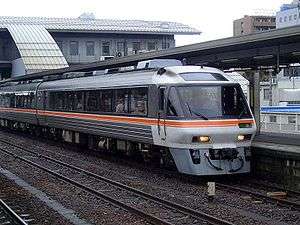Hida (train)
The Hida (ひだ, Hida) is a limited express train service operated by Central Japan Railway Company (JR Central) along the Takayama Main Line in central Japan since 1958, which connects Nagoya and Takayama in just over 2 hours, Osaka and Takayama in 4 hours 15 minutes and Nagoya and Toyama in 4 hours. The Hida serves various locations en route such as Gifu and Gero.

Overview
5 round trips operate from Nagoya to Takayama, and five more continue past Takayama to Toyama. Additionally, one service runs from Osaka to Takayama. This service runs from Osaka to Gifu before coupling with a Hida service from Nagoya and continuing to Takayama. [1][2] Trains operate at a maximum speed of 120 km/h (75 mph).
Stations called at
Brackets () denote stations that not all Hida services stop at.
Nagoya – (Owari-Ichinomiya) – Gifu – (Unuma) – Mino-Ota – (Shirakawaguchi) – (Hida-Kanayama) – Gero – (Hida-Hagiwara) – (Hida-Osaka) – (Kuguno) – Takayama
Some services continue to Toyama: Hida-Furukawa – Inotani – Etchu-Yatsuo – (Hayahoshi) – Toyama
Osaka service: Osaka – Shin-Osaka – Kyoto – Kusatsu – Maibara – Ogaki – Gifu (Couple with service from Nagoya) - Unuma – Mino-Ota – Shirakawaguchi – Hida-Kanayama – Gero – Hida-Hagiwara - Hida-Osaka – Kuguno – Takayama
Facilities
Standard class and Green class is available on this service, although not all services carry a Green car. Seat reservations can be made for an extra fee. There is one or more universal access toilets, as well as normal toilets, depending on how many carriages are being used for the service. There are also wheelchair spaces. No catering facilities are available on this train. There is a vending machine onboard, which provides a small selection of drinks. Complimentary WiFi is also available.
The service is known for its window that wraps around the cockpit offering un-interrupted views of the tracks in front of or behind the train; hence, a longer name for this service is Wide View Hida as is the case for other JR Central limited express services. Passengers who wish to use this seat have to pay the "Green Car" fare and request the seat specifically.[3]
History
The service began on 1 March 1958.
After Typhoon Tokage in 2004, the track suffered major damage from flooding. As a result, instead of going all the way to Toyama Station, trains could only go as far as Hida-Furukawa Station until September 8, 2007, when the track was repaired and again reached all the way to Toyama Station.[4]
Rolling stock
All trains are formed of KiHa 85 diesel multiple unit (DMU) sets, usually as 3-, 4-, 6-, or 7-car formations, or occasionally 10-car formations, especially during busy seasons.
KiHa 80 series DMUs were used from the start of operation in 1958 until 1990. KiHa 85 series trains have been used since 1989.
New HC85 series hybrid trains are planned to be introduced on the service in 2022.
References
- Lambe, Michael. "The Limited Express Hida for Gifu, Gero, Takayama, & Toyama". Nagoya Station. Japan Station Network. Retrieved 22 March 2020.
- Lambe, Michael. "The Limited Express Hida for Gifu, Gero, and Takayama". Osaka Station. Japan Station Network. Retrieved 22 March 2020.
- "TrainReview". trainreview.com. Retrieved 2020-07-12.
- 高山線全線の運転再開について (About resuming the operation of whole Takayama Line) Archived 2007-06-23 at the Wayback Machine, news release by JR Central.
.svg.png)